Currently Browsing
For Parents
25 Ways to Show Kids You Care About Them
- 9 February //
- Posted in For Parents, Teaching Resources //
- Tags : parent
- Comments Off on 25 Ways to Show Kids You Care About Them

You can spend hours trying to teach kids right from wrong and filling their heads with knowledge, but at the end of the day they just want to know you care about them. Of course, simply telling them that you care about them isn’t good enough. As we often tell kids, “Actions speak louder than words.”
We’ve gathered up a list of simple ways to show kids you care about them. Use them regularly and you may begin to find that the kids you interact with on a daily basis are happier and more likely to follow your guidance, all because they know that you care.
Our List of Ways To Show Kids That You Care About Them
1. Keep Your Word
Kids pay attention to what you say. If you make a promise, keep it. If you’re not sure you’ll be able to keep a promise, then say, “I’ll try my best, but I can’t guarantee it.”
2. Be Honest
Kids value your opinion and nothing lets them down like learning that you’ve lied to them. Little white lies, like “Wow! That’s a great painting,” are fine. Bigger lies that they could discover, “Like, I’d love to go to your game, but I have to stay late and grade papers,” are not.
3. Encourage Their Dreams
Even if their dream is to become a giraffe, encourage it. “I bet you’ll be the best giraffe there is!” Kids need to be encouraged to dream and think creatively.
4. Write Them Notes of Encouragement
Little notes like “Keep up the good work” or “Great job on your presentation” will help motivate kids and show them that you notice them. You don’t have to give notes for everything they do. A little encouragement once a week or so will go a long way.
5. Compliment Them
Randomly take some time to pay them a compliment, even if it’s just something as small as, “I really like your sweater today.” This also helps kids know you notice them.
6. Tell Them You’re Proud of Them
If you’ve ever told a preschooler or elementary-aged child you’re proud of them, you probably saw a positive reaction. Kids have a desire to make grown-ups proud and hearing that they have done so gives them a wonderful feeling.
7. Catch Them Doing Something Good
As parents and teachers, we often catch kids doing something bad. However, we should work harder to catch them doing something good, and then point it out. For example, “I noticed you helped Kayla pick up the crayons she spilled. Thanks for being so helpful.”
8. Don’t Point Out Every Mistake
Kids don’t always recognize that pointing out their mistakes is a way of showing you care. Instead they think, “I can never do anything right.” When you see little mistakes, let them go. Chances are the kids recognize them and are working on fixing them themselves.
9. Say Yes Frequently
Just like kids don’t like it when you point out their mistakes, they don’t like to hear the word no. Even though your no may be justified, saying no too many times can give kids a negative feeling. Some experts suggest trying to say yes two or three times for every no.
10. Give Them a Hug
Or a pat on the back, a high five, or a handshake. If you’re a teacher, you might have to be careful about touching students, but there’s nothing wrong with a simple high five or a handshake to say, “Job well done.” A simple pat on the back can say, “I know you’re struggling and I’m here for you.”
11. Cheer Them Up When They’re Having a Bad Day
Usually when a kid is having a bad day, you can tell. While a hug or pat on the back can help, sometimes you just need to lighten the mood. Tell a joke. Point out something silly. Make a crazy face. Sometimes that’s enough to help kids redirect and forget about their bad mood for a moment.
12. Be Silly with Them
Kids love to sing silly songs, make silly faces, and enjoy other silly actions. Next time you’re singing that crazy song or reading a silly book, take time to make zany noises or motions. Kids need to know you’re not so stuffy and that you’re willing to let your guard down with them.
13. Smile at Them
Let kids know you’re happy to see them by giving them a smile. In the classroom, greet them with a smile in the morning and send them off with a smile in the afternoon. Whenever they catch your eye, smile to show you care.
14. Be Approachable
If you always have a frown on your face or constantly tell your kids that it’s not a good time, they’re going to stop coming to you. Let them know they’re important by making some time for them when they come to you. If you truly are busy and it’s a bad time, say something like, “I want to hear this. Give me five minutes to finish it and then I’m all ears.”
15. Talk to Them
Of course you talk to kids every day, but do you take time to just let them talk? Take a few minutes to let kids tell you something interesting or share what’s on their mind. Respond to them appropriately, but let them do the majority of the talking.
16. Play with Them
Making Barbie talk or rolling toy cars around of the floor may not be your idea of fun, but you should still take time to enjoy these activities with kids. Just five or ten minutes of play lets kids know you want to spend time with them.
17. Take an Interest in Their Interests
One of the best ways to let kids know you care is to take an interest in something they’re interested in. If they have a favorite TV show, learn the theme song and the names of the characters. If they have a favorite sport, know some of the rules of the game. Kids will be impressed when you can spout off some of this knowledge on the fly.
18. Ask for Their Input
Kids have opinions and love to be given the opportunity to express them. If you have a decision to make involving your home or classroom, give kids some input. This lets them know that their opinions matter.
19. Let Them Help You
Many hands make light work, but when those hands are little, they can often make work take a lot longer. However, giving kids little tasks to do makes them feel important, so find ways they can help.
20. Be Patient
The simplest tasks, such as zipping a coat or putting on a pair of shoes, can take forever with kids. Instead of constantly saying, “Hurry up” or showing other signs of impatience, stay calm and give them the time they need.
21. Make Them Feel Safe
Feeling safe is really important to kids. If you’re a teacher, you may have kids that have unstable home environments, so school has to be a safe place for them. Make kids feel safe by establishing rules, creating a cozy environment, and controlling your emotions when they’re around.
22. Stand Up for Them
Kids need adults to advocate for them. Let them know that you’re always in their corner by standing up for them when they’re wronged and by helping them fight their battles. However, don’t come to their defense so often that they don’t learn how to handle problems themselves.
23. Show Up to Their Events
If kids participate in extracurricular activities or have a special event scheduled, take the time to show up. Nothing says “I care about you” more than having their teacher or parents show up to an event they’ve been preparing for. Showing up says that you care enough to give up some of your time for them.
24. Display Their Work
If kids draw you a picture or make you a gift, display it proudly. You can also put a picture of the child in a special place. Let them know that they and their work are worthy of being on display.
25. Remember Their Birthdays
Birthdays are a big deal for kids. Even if all you do is say, “Happy Birthday,” acknowledging their special day will show them you care. Even better, give them a special sticker, birthday hat, or a small birthday treat.
Whether you’re a parent, teacher, or work with children in another way, you should take time to show them that you care. Do you have other ways to show kids you care? If so, share them with us so we can use them on the kids in our lives!
See our printable worksheets for ideas and be sure to check out KidsKonnecy too. They’ve got a fantastic Random Acts of Kindness worksheet pack with a a free sample available to inspire you further!
How to learn about and celebrate Hanukkah
- 29 November //
- Posted in For Parents, Teaching Resources //
- Tags : hanukkah, ideas, teacher resources, ultimate guide, winter
- Comments Off on How to learn about and celebrate Hanukkah

Whether you’re Jewish or want to teach your students more about this popular observance, we unpack the holiday and list activities and worksheets that you can use to celebrate Hanukkah!
Although it doesn’t rank among the most important of the Jewish holidays, Hanukkah is one of the most widely observed Jewish celebrations. This eight-day “Festival of Lights” illuminates what is, for many in the northern hemisphere, the darkest, coldest season of the year.
Hanukkah brings light, joy, and warmth to our homes and communities. The holiday’s central ritual of lighting candles of a menorah each day literally brings light to the darkness. Metaphorically, the presence of light is reflected in an emphasis on charitable donations and, for some Jews, a commitment to social action and social justice.
Celebrate Hanukkah by Learning it’s Origins
Hanukkah (sometimes spelled Chanukah) recalls the second-century BC victory of a small group of Jewish rebels (led by Judas Maccabeus and his brothers, known together as “the Maccabees”) over the armies of the Seleucid Empire. The Maccabees seized control of Judea and founded the Hasmonean dynasty, which ruled for over 100 years.
Hanukkah means “dedication” in Hebrew, because the major accomplishment of the Maccabees was a rededication of the Jerusalem Temple, which for many years had been used for the worship of Persian and Greek deities. The Maccabees were also responsible for expanding the boundaries of Judea and reducing the influence of what they considered pagan Hellenism.
The miracle of Hanukkah, which is reflected in the lighting of candles and eating foods prepared in oil, comes from the story that when the Maccabees rescued the Temple from the Seleucids, they could only find one small cruse of oil that bore the seal of the priests. All the others had been profaned. There was only enough oil to light the Temple’s menorah for one day. Instead, by a miracle, the oil lasted eight days and nights – long enough for the priests to prepare and consecrate new oil.
Why does the date of Hanukkah change every year?
Hanukkah always starts at sundown on the 25th day of the month of Kislev on the Hebrew calendar. All days on the Jewish calendar start at nightfall. The secular date of Hanukkah changes every year because the Hebrew calendar is based on the lunar cycle. Hanukkah can occur anytime between November 28th and December 26th. This year it begins at sunset on December 10, 2020. In 2021, Hanukkah begins on the evening of November 28. The annual festival of lights happens in 2022 starting on December 18.
Free and Premium worksheets and activities to celebrate Hanukkah
Help Teaching has surveyed many Hanukkah-related educational resources for you to download and use. Here are the highlights:
Our own Hanukkah-themed resources include:
- FREE Hanukkah matching
- FREE Hanukkah fill in the blanks
- FREE Read aloud story of Hanukkah
- PRO Hanukkah tens and ones
There are many others listed in our Winter Holidays worksheet collection that cover ELA, math, sciences, games and puzzles, and more.
Fun Hanukkah activities
Hanukkah is a special time to enjoy with friends and family, and fun games and activities are part of the tradition.
- Hanukkah Mad Lib: Children will have fun spinning the dreidel and doing some Hanukkah Mad Libs which will provide hours of laughs while helping kids expand their knowledge of parts of speech. If you don’t want to buy the book, make your own Mad Libs, or try this free one from My Jewish Learning.
- Listen and Learn: Older children and adults will enjoy listening to stories of the season on “Hanukkah Lights” from National Public Radio carried on stations across the country. For more than 15 years, NPR has offered original stories inspired by the Jewish festival of lights. Hosted by NPR’s Susan Stamberg, and Murray Horwitz, each year Hanukkah Lights marks the age-old Jewish celebration with contemporary fiction. Previous years’ episodes are available free and on-demand.
- Get cooking: Food is a delicious part of Hanukkah. Holiday treats include latkes, sufganiyot, bimuelos (fried dough puffs) and keftes de prasas (leek patties). You and your kids will enjoy watching the PBS program “Sara’s Weeknight Meals: Jewish Holidays” airing on many stations across the country. Find out where and when or watch on YouTube. Sara Moulton serves up two traditional Hanukkah dishes that are tricky to prepare. Step by step, she takes us through the process, starting with Braised Brisket, and on the side, her Aunt Rifka’s recipe for matzo balls they call ‘flying disks’. Sara and her nephew visit the farm and food incubator Stone Barns in Westchester, New York, to get fresh winter vegetables for her Root Vegetable Latkes.
- Games: These involve making your own simple cutout crafts from construction paper or card stock
- Play “Pin the Candle on the Menorah”. Have your kids draw and color a giant menorah on posterboard, then make cutout candles to stick on while blindfolded. Kids take turns until all eight candles are placed.
- Make a “tick, tack, toe” game out of dreidels and menorahs using hand drawn and cut out pieces and a hand-drawn game board. Many crafts stores sell foam Hanukkah stickers which can be used as game pieces
- Crafts:
- Make a Star of David and Menorah sculptures out of popsicle sticks and a little glue. Color the sticks beforehand. You could use pipe cleaners instead of sticks.
- Organize a plate of fruit into the shape of a menorah
- There are more great craft ideas listed here.
You will find 101 Hanukkah activities for kids of all ages at care.com.
Printable worksheets
Printable worksheets are a great way to engage students in learning a new topic. KidsKonnect is a growing library of high-quality, printable worksheets for teachers and homeschoolers. They have loads of Hanukkah Facts and Worksheets that include a fact file and activities for a range of ability levels.
Hanukkah online and multi-media resources
My Jewish Learning is offering a live community candle-lighting over Zoom every night of Hanukkah.
ReformJudaism.org has a platter full of Hanukkah resources, videos, recipes, and activities for all ages.
Making your classroom more holiday-inclusive
This can be a challenge, particularly in today’s pluralistic society. Here are a few ideas for celebrating holiday ideas upon which most families can agree no matter their faith or absence of it.
- Move the spotlight off the individual student and onto others by underscoring the spirit of giving
- Students can study figures from history who spent their lives focused on the needs of others
- Children can also make gifts for each other, their parents/guardians, or other family members
- Have your students taking part in a food drive or toy drive as a method to teach about the spirit of giving
- Create multicultural celebrations
- Acknowledging the various beliefs of students in your classroom can extend beyond the month of December
- Celebrations of the major holidays of various faiths could occur throughout the year at the appropriate time
- Why not make a commemoration of a holiday an opportunity to give a history lesson on the development of the holiday?
- You can have your students investigate the cultural significance of the celebration
- Learning about various faiths does not signify an endorsement by you or the school of that belief system
- Limit celebrations to foundational ideas
- A vital part of multiculturalism is to teach children about various points of view
- By focusing on common ideas such as charity, celebrations become more universal without the added layer of religious debate
- Maintain anti-bias goals
- Holiday celebrations are a great way to have students examine the similarities and differences of our shared society
- Shedding light on these differences, and celebrating them in a non-judgmental manner, is a great lesson for children to learn
- Finally, keep parents/guardians informed
- Let the parents/guardians of your students know ahead of time what and how religious holidays will be commemorated
- In this way, parents can nuance what you are teaching in the classroom with their own beliefs
- Some parents may want their child to opt out of the holiday celebration, so be prepared with an appropriate response which honors their beliefs
- Let your school administrator know what you will be doing with regard to religious holidays, and follow the school’s guidance on the issue
Teachers and administrators may find this article helpful when assessing options for instruction about religions in U.S. public schools.
Hanukkah may be a Jewish holiday, but this festival of lights can be celebrated by all.
Hanukkah sameach!
Image source: Hanging Stars Vectors by Vecteezy
Ultimate Guide to Educational Toys for Kids
- 25 November //
- Posted in For Parents, Teaching Resources //
- Tags : gifts, parent resources, ultimate guide
- Comments Off on Ultimate Guide to Educational Toys for Kids

Did you know it’s possible to have fun and learn at the same time? While it’s great for kids to play with toys, their young minds are at the prime stage for taking in information and learning new skills. The solution? Toys that allow kids to learn while they play. This year when you shop for holiday and birthday gifts, opt for something with educational value.
Need help finding ideas? We’ve rounded up some of the top educational toys for kids.
Disclosure: HelpTeaching partnered with the companies of some our top picks to provide items for a giveaway, but all items were chosen for their quality educational value.
|
JUMP TO:
|
Babies | Toddlers | Preschoolers |
| Early Elementary | Upper Elementary | ||
| Pre-Teens | Teens |
Babies
Even though babies won’t remember whether you bought them a gift for Christmas or their birthday, sometimes you still want to get them something. Instead of adding another stuffed animal to their collection, try one of these options.
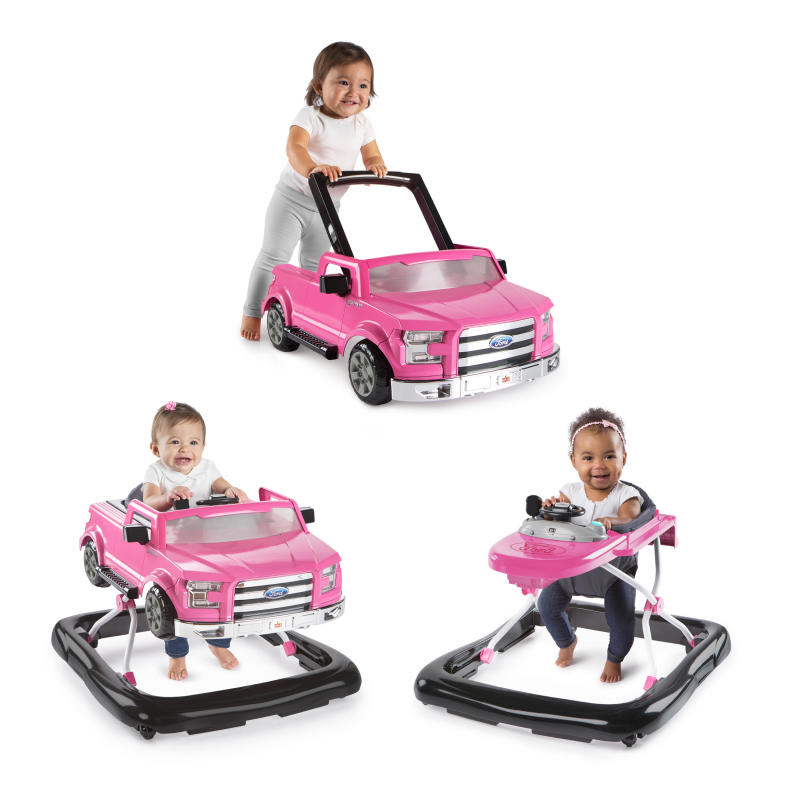
TOP PICK: 3 Ways to Play Walker – Ford F-150 – Never underestimate the power of observation. This walker allows babies to explore the world around them in three different ways, including a normal walker and push-behind mode. The steering wheel and authentic truck sounds and lights make the walker even more adorable.
Baby’s First Blocks: Nothing beats a classic shape sorting toy for babies and toddlers. Baby’s First Blocks from Fisher-Price features a handy tub to collect the shapes and a handle for carrying it. Babies and toddlers will learn to grab, manipulate, and match the shapes.
Skip Hop Activity Mirror: Mirrors are great toys for babies. They allow them to explore the world around them and also begin to recognize their own face. This mirror from Skip Hop is just one of many baby mirrors that can be attached to the seat of a car or the bar of a stroller for babies to enjoy.

Munchkin Mozart Magic Cube: Babies love music and this magic cube combines music with lessons in cause and effect and tempo to create a fun learning experience for babies. They can press different parts of the cube to add instruments to the orchestra and see lights flash with the tempo of the music.
Go Car: This car comes with a handle to make it easy for babies to hold on to it and control the way it moves. It also glides smoothly on different surfaces, helping babies begin to learn about the concept of movement.
What’s Inside Toy Box?: With the What’s Inside Toy Box, babies begin to learn that objects have names and also build motor skills as they reach in and pull out objects or put objects back in. Additionally, this toy can help teach object permanence.
All About Me Personalized Photo Book: Babies can learn the names and faces of loved ones, pets, and other special people or places in their lives with this photo book. Parents can insert photographs in protected compartments so babies can flip through and look at them.
Toddlers
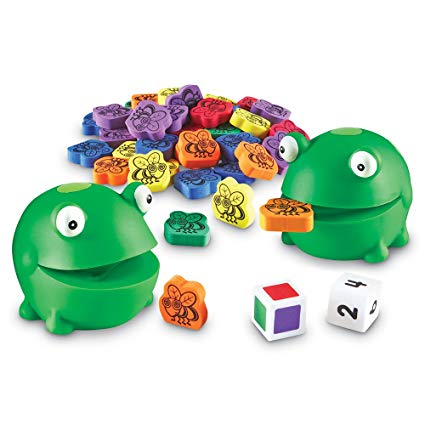
TOP PICK: Froggy Feeding Fun – Little kids can boost their fine motor skills, learn their colors, and practice their counting skills with this fun frog feeding game. Simply roll the dice and feed the frogs the correct flies. Note that the fly pieces may present a choking hazard so kids should be supervised while playing.
Start-Up Circuits: Toddlers who enjoy playing with switches will enjoy these toys that help them begin to understand how circuits work. Simply flip the switch to make each object work.
Wooden Building Blocks: Blocks are a favorite for toddlers because they help them build motor skills and begin to understand geometrical concepts. This set from Pidoko Kids features 50 colorful blocks in different shapes and comes with a container for carrying them all.
Personalized Name Puzzle: One of the first things a toddler learns how to spell is his/her name. Help develop that skill and help your toddler start learning how to complete puzzles with a personalized name puzzle.
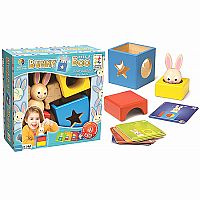
Color Discovery Boxes: Color Discovery Boxes help toddlers learn their colors and begin to categorize objects. Each box contains multiple objects to represent the color. Mix the objects up and have toddlers sort them and put them back where they belong.
Bunny Peek a Boo: This fun game helps toddlers learn about prepositions and object placement. They must look at the cards and try to create the scene with the bunny and various blocks. Parents are encouraged to give clues and talk about where the bunny is. For example, “The bunny is behind the box.”
Learn the Alphabet Dough Mats: You can print out and laminate your own dough mats or you can buy these handy mats which feature uppercase and lowercase letters. These help kids learn letters and build fine motor skills.
Size and Sequence Farm Puzzles: Size and Sequence Farm Puzzles have toddlers put the puzzle pieces in order by size. This set of puzzles helps them learn how to organize objects from smallest to largest.
Dress-Up Career Set: Toddlers can learn a lot from dressing up, especially when they dress up to represent different careers. With this set, your toddler can pretend to be someone else nearly every day of the week.
Seek A Boo: Seek A Boo is a fun game designed to get toddlers and preschoolers moving and help them learn how to categorize objects. Basically, it works like a game of “I Spy” where kids must find a circle that meets a particular description. Adults and kids can take turns coming up with questions.
Preschoolers
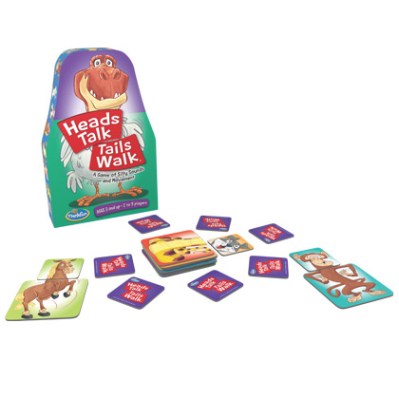
TOP PICK: Heads Talk Tails Walk – ThinkFun’s game of silly sounds and movement has kids try to match hidden head cards to the correct bodies. If the body parts don’t match, kids have to try and act out their crazy new animals.
Yeti Forgetti Memory Game – This hide and peek memory game gets kids in on the action. Cards direct kids to shuffle the igloos and try to find the locations of the different yetis in the game while watching out for the evil snow crab for a twist on a classic shell game.
Bear Counters: Bear Counters and counting cubes can be used by preschoolers in a variety of ways. Not only are they good for counting practice, but they can also be used for creating patterns and measuring.

Fun Express Happy Kids Hand Puppets: This adorable set of hand puppets features kids from different ethnic backgrounds. It’s great to include with a puppet theater and to use to act out social stories to help get preschoolers thinking about their actions and emotions.
Toss Across: If you’re looking for a fun game to get kids moving, try Toss Across, a game that helps kids practice their throwing skills and learn about patterns while playing a game of tic tac toe.
Periodic Table Blocks: Make block play a little more educational by having kids learn the elements of the periodic table at the same time. These square blocks are great for building and also feature the names, symbols, and atomic numbers of various elements.
Mosaic Mysteries Pattern Puzzle: Kids can build fine motor skills and create patterns when they play with the Mosaic Mysteries Pattern Puzzle, an activity that features connecting tiles to create a mosaic.
Early Elementary
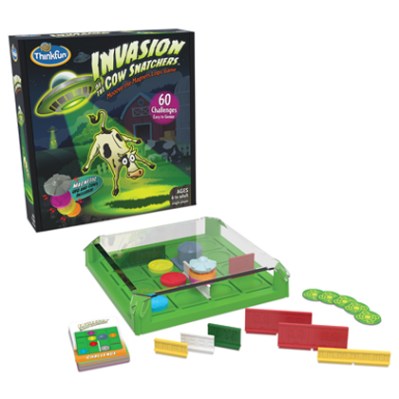
TOP PICK: Invasion of the Cow Snatchers – Kids can build their logic and problem-solving skills with this exciting STEM game from ThinkFun. While the game can be enjoyed by kids as young as 6, even older kids, teens, and adults will enjoy trying to solve some of the genius-level challenges.
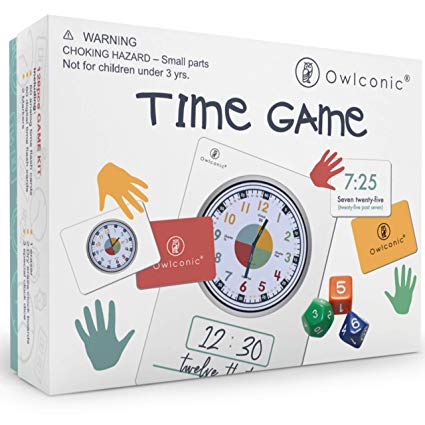
TOP PICK: Owlconic Telling Time Teaching Game – For teachers and homeschool parents looking for new ways to help kids learn to tell time, this telling time game is exactly what you need. It helps kids make connections between digital and analog time while also working on memory skills and fractions.
Teaching Talking Cash Register: This cash register is a favorite of kids because it offers many functions. Kids can play store or open a real store and the cash register will help them add up totals and calculate change. It also features a fun scanner.
Melissa and Doug Magnetic Human Body: Kids can learn the different parts of the human body by taking them on and off the wooden form. It’s a great, non-gory way for kids to begin to explore what makes up the body.
Magformers: Magformers feature fun tiles that connect to one another. Kids can use them to build unique structures.
Magnetic Science: Magnetic Science contains 38 pieces to help kids explore magnets and their various uses.

Precision School Balance: With a balance, kids can practice weighing items and comparing different weights. For example, is a carrot heavier than four quarters?
Dive into Shapes: Using a series of rods and balls, kids can build their understanding of geometry as they try to recreate the shapes on the cards.
Sum Swamp: Sum Swamp is a fun game that helps kids build their addition and subtraction skills.
Paper Airplane Conversion Kit: With the help of a grown-up, kids can use this kit to make a variety of paper planes and see how long they fly electronically.
Beaker Creatures: Learning Resources has created a fun science toy where kids can conduct experiments to reveal hidden creatures. Kids simply pop a reactor pod into the chamber, complete the steps, and discover a surprise. They learn about the scientific method and follow directions at the same time.
Upper Elementary
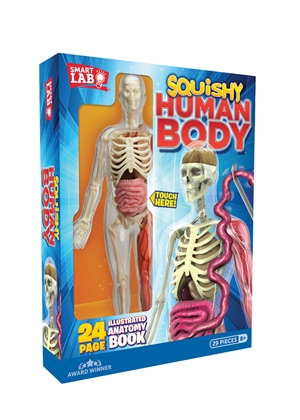
TOP PICK: Squishy Human Body – SmartLab Toys helps kids explore the body through this unique model. The body includes 21 vital organs, bones, and body parts, as well as a 24-page anatomy book and other resources to help kids explore the model.
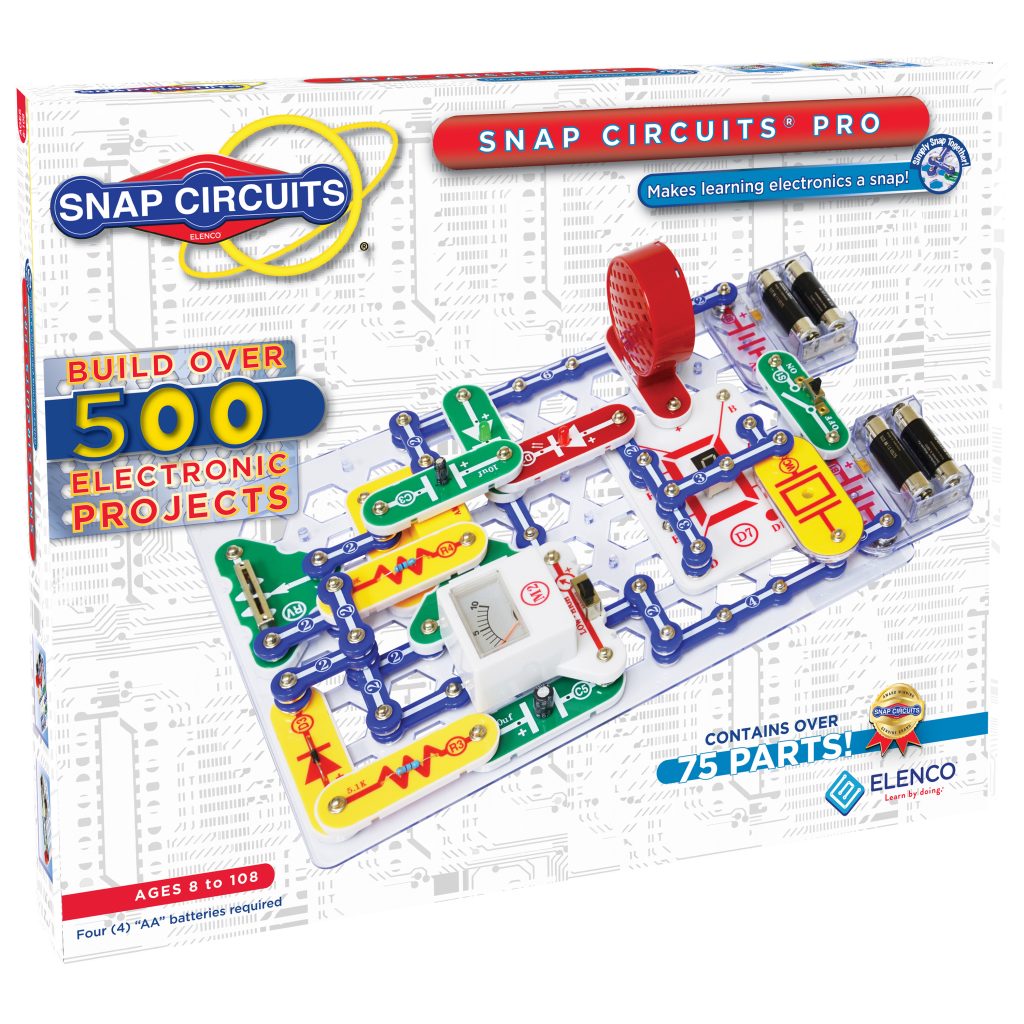
TOP PICK: Snap Circuits Pro – With over 75 snap-together parts and 500 exciting projects to complete, kids can learn all about electronic circuits and the basics of electricity. This kit is great for building STEM, problem-solving, and logic skills.
Adopt an Animal: Start teaching your child about giving back and becoming more aware of the world by adopting an animal. The kit comes with a certificate and a stuffed animal.
Kiwi Crate offers maker kits for kids up to age 16. Try Doodle or Tinker Crate for ages 9-16 and Kiwi for ages 5-8. Sign up for a monthly subscription box. Each box comes with fun STEM and STEAM activities for kids.
Tin Can Robot: Take an ordinary tin can and turn it into something cool with the Tin Can Robot kit. Using this kit, kids can build their own robot.
Star Wars Death Star Electronic Lab: Star Wars fans will love the challenge of the Death star Electronic Lab which has them connect circuits to help bring the Death Star to life.
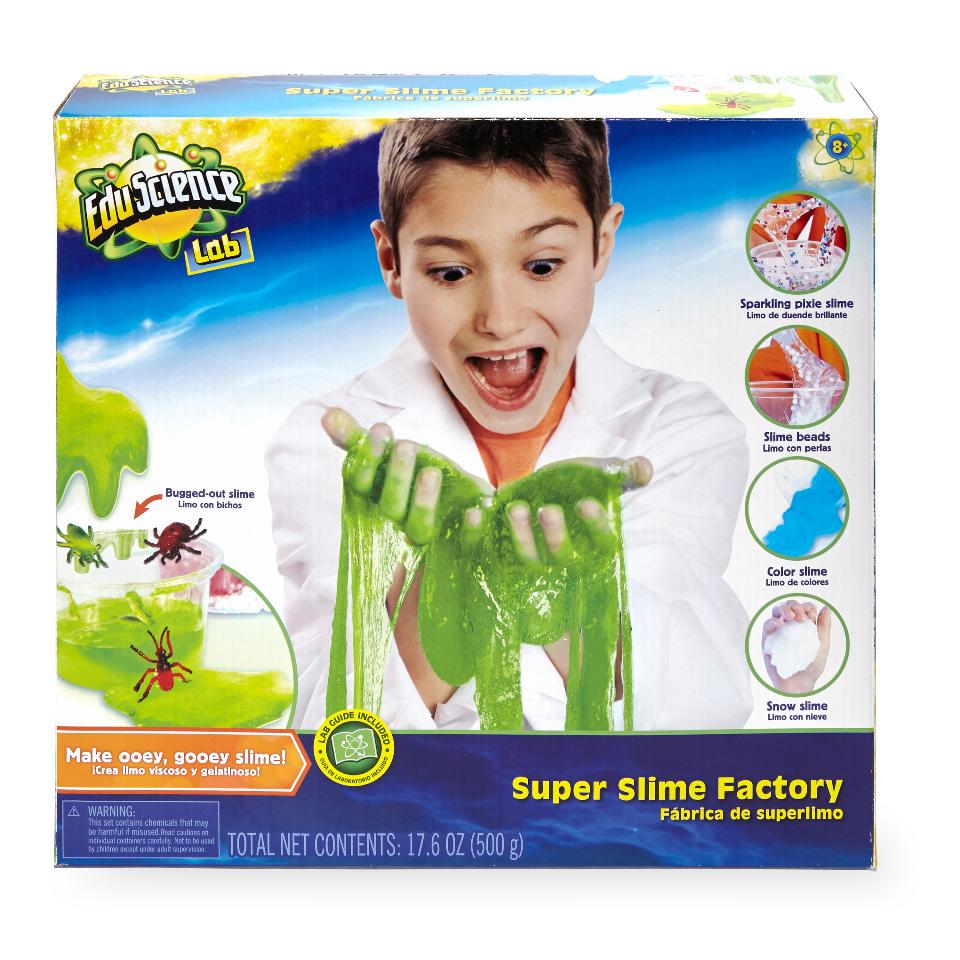
Super Slime Factory: Slime is all the rage these days and the Super Slime Factory gives kids the chance to make their own slime while learning a bit about the science that goes into the process.
Qwirkle: Qwirkle is a fun game with a dominoes-like feel. Kids must match the shapes and colors, but they also have to use a bit of strategy to win the game.
Keva Contraptions: With Keva, kids can learn about engineering and geometry. This set allows kids to build unique contraptions and also comes with two balls. Perhaps kids will use them to make an epic marble run.
Create a Maze: With the Create-a-Maze set, kids are tasked with re-creating the maze on a card and then trying to get a ball through the maze.
Klutz LEGO Chain Reactions Craft Kit: This book and LEGO set helps kids learn how to build simple machines and put them to use, introducing them to the laws of physics at the same time.
For preschoolers through upper elementary school students, you can also put together a craft kit, full of supplies, such as googly eyes, stickers, craft sticks, and glitter glue, to make a variety of crafts and to encourage kids to use their imaginations.
Pre-Teens
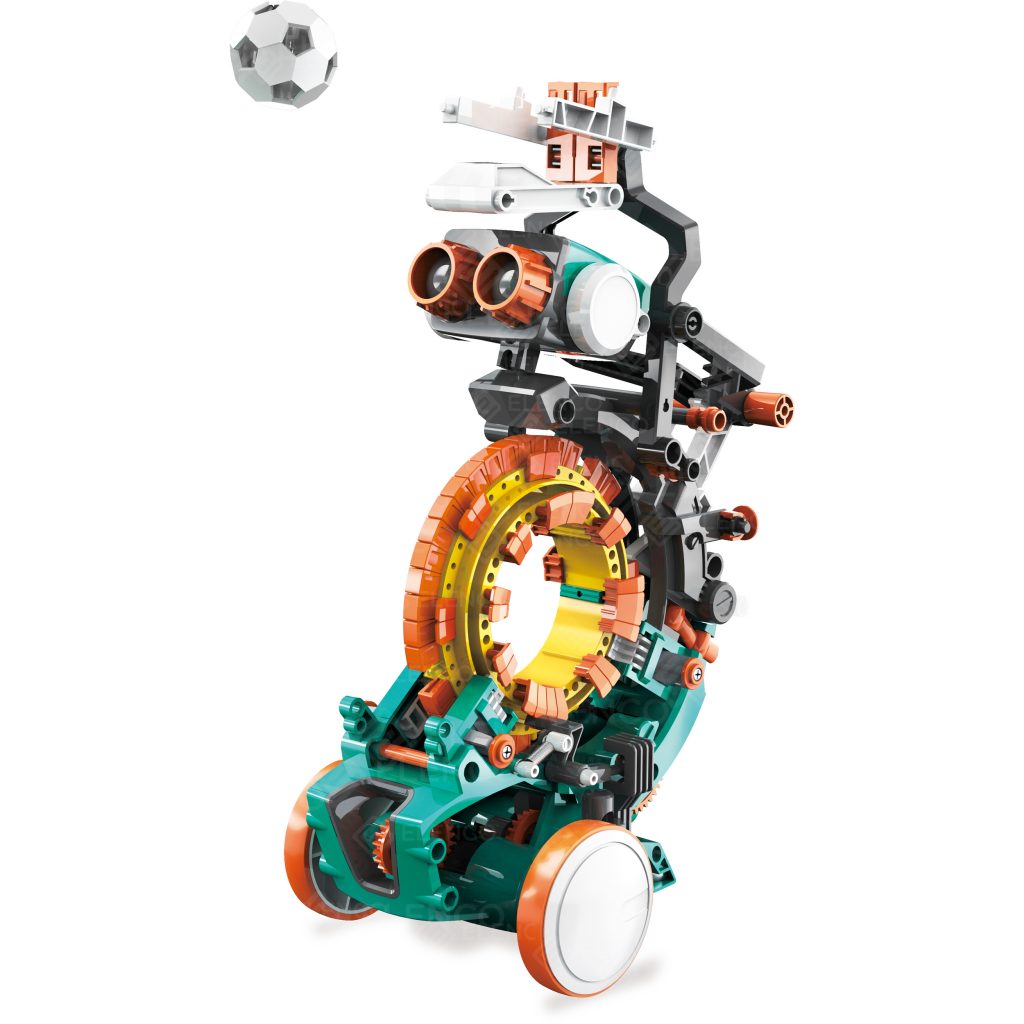
TOP PICK: Elenco Teach Tech Mech-5 Coding Robot – This STEM coding robot introduces kids and teens to the principles of mechanical engineering. They work with their robot to get it to perform tasks such as kicking, throwing, lifting, and even drawing.
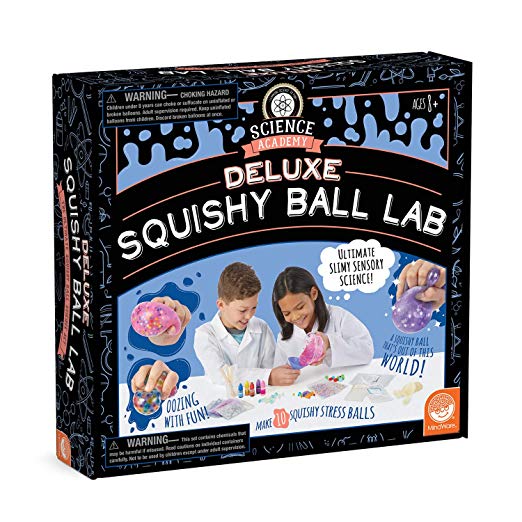
TOP PICK: Science Academy Deluxe Squishy Ball Lab – Encourage kids and tweens to get their hands dirty and make their own squishy stress balls. The kit is great for boosting STEM skills and getting in some sensory fun.
Kano Computer: Pre-teens who enjoy coding and working with electronics, but are not quite ready to work on a full-fledged computer will appreciate Kano Computer, which allows them to build their own mini-computer.
Perfume Maker: A lot of science goes into the creation of perfume. This set allows pre-teens to make their own scents while learning at the same time.
Spa Soaps Kit: Let pre-teens make their own spa soaps, and then use them to host a spa party for their friends. Better yet, they can package their soaps and give them as gifts to others.
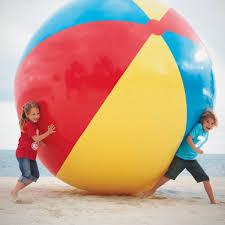
Giant Inflatable Ball: Encourage pre-teens to get outside and be active by purchasing a giant inflatable ball. They can make up their own fun games to go with the ball too.
Boxed Book Sets : If you know a pre-teen loves to read or has a favorite series, consider purchasing a boxed set. The Giver trilogy by Lois Lowry is a great set to consider.
Eco-Friendly Bean Bag: Instead of a normal bean bag, opt for an eco-friendly bean bag. The gift will teach pre-teens about being more environmentally conscious.
Build Your Own Pinball: Kids and teens can learn about engineering by building their own pinball game with this fun set.
Teens

Displates: Give teens a unique gift that teaches them to value creativity and different art forms. Displates come in different styles and relate to interests such as popular movies and TV shows or musical instruments.
Ion: A Compound Building Game – Know a teen struggling with chemistry? Find some STEM fun and refresh that chem knowledge with a fun game that has kids and teens collect cards and build chemical compounds.
Quadcopter: What’s more fun than a drone? A drone with a camera. Teens can make their own videos and take pictures as they fly their drones.
Marvel Puzzle: Have a superhero fan? Give them a superhero puzzle so they can enjoy some of their favorite skills and they put their puzzle-solving skills to the test.

Codenames Disney: Codenames is a fun word association game. Purchase the Disney version or another themed-version and play it with your teen.
Die Cast Spirograph: Spirograph may seem like a kids’ toy, but this version of the classic drawing kit is super sleek. Teens may find creating their own spiral shapes relaxing.
Games: World of Puzzles: Purchase a subscription to a magazine such as Games: World of Puzzles. This fun magazine includes many different puzzles for teens and adults to solve.
Game of Phones: Teens are always on their phones. Get them to interact with one another with this fun game which has them use their phones to send messages and complete challenges.
My Cinema Lightbox: A lightbox is a fun way to get teens to write. They can come up with creative messages or even practice spelling vocabulary words.
In addition to the gifts listed above, consider purchasing apps and other digital gifts for teens or giving them a gift card to purchase music and apps for their phones or tablets.
Do you know of any must-have educational gifts for kids or teens? If so, we’d love to hear your ideas. Share them in the comments!
*This list may contain affiliate links and some companies provided products for review, but all views expressed are our own.
If you enjoyed this read, you might also like what KidsKonnect has to say. Check out their articles today.
Alternative Thanksgiving Traditions
- 19 November //
- Posted in For Parents, Teaching Resources //
- Tags : thanksgiving
- Comments Off on Alternative Thanksgiving Traditions
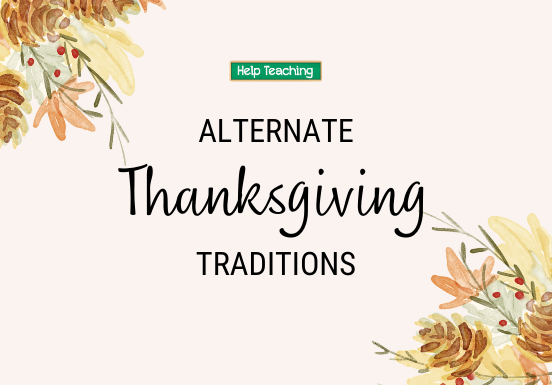
Whether you don’t have family nearby or are tired of the traditional turkey and stuffing, this is the year to try something new. From celebrating friends to participating in a 5K, there are many different ways to celebrate this Thanksgiving. Who knows? These alternative thanksgiving traditions could become your or your children’s traditions for years to come.
Here’s our list of Alternative Thanksgiving Traditions:
Celebrate Friendsgiving
Instead of shelling out hundreds of dollars to travel home or eating a TV dinner alone, gather together some friends for a Friendsgiving. A Friendsgiving is typically celebrated on the day before or the day after Thanksgiving, but you can also celebrate it on the actual day. The goal is to gather together with friends and enjoy a meal together.
A traditional Friendsgiving works similar to a potluck. One friend agrees to host and provide the turkey, chicken or ham. The other guests bring side dishes and desserts. If you’re not much of a cook, store-bought dishes are completely acceptable. You could even all go in together and purchase a full Thanksgiving dinner from your local grocery store or favorite restaurant.
For a unique take on a Thanksgiving meal, try a progressive dinner where a different friend hosts each course of the meal. This works particularly well if you all live close together. If no one has the space to host, head to a local diner or a restaurant like Denny’s (as declared in Tim Allen’s The Santa Clause, they’re always open).
Give Back to Others
Instead of eating at home on Thanksgiving, spend some time giving back to others. You can go the traditional service route and sign up to serve Thanksgiving dinner at a local soup kitchen or try something a little different. Giving back also teaches kids an important lesson about the value of serving others and may help them realize they have a lot to be thankful for. Some ways to give back to others on Thanksgiving include:
- Deliver food boxes or turkey dinners to people in need
- Collecting holiday gifts for children
- Put together care packages to send to members of the military
- Send cards to people you miss
- Visit a local nursing home
- Provide a treat to the staff at a local hospital
- Go to a restaurant and leave your server a large tip
- Clean out your cupboards to gather food for a local food pantry
- Contact a local college and offer to host students who stayed on campus during the holidays
Get Fit
On Thanksgiving morning, thousands of people gather to participate in “Turkey Trots” around the United States. These 5Ks have become a Thanksgiving tradition of their own. Gather some friends together and enter the race together or run solo and meet new friends along the route. Many 5Ks also have special fun runs or walks, so kids can join in the fun too. If you’re not a fan of running, you can always walk the 5K or volunteer to help out with the race in another way. When the race is over, treat yourself to a hearty Thanksgiving meal.
If you’re missing your family’s annual touch football game, organize one of your own. Meet your friends at a local park or advertise the game on a local events page so others without family in the area can join you.
Have a Movie Marathon
Thanksgiving is a big day for movie releases. Head to your local movie theater and spend the day hopping from theater to theater to enjoy them all. Just be sure you purchase a ticket for each movie. If you prefer a cheaper option, invite some friends to your house for a Christmas movie marathon or a showing of “A Charlie Brown Thanksgiving.” If kids are included, pull out all of your old holiday favorites, such as “Rudolph the Red-Nosed Reindeer” and “Frosty the Snowman.”
Go International
Many other countries celebrate their own versions of Thanksgiving throughout the year. Introducing elements of other cultures can also turn itno a mini-geography lesson for kids. Consider adopting one of these traditions for Thanksgiving:
- In Jewish culture, some families build a hut from branches called a Sukkot. Then they eat a meal beneath the hut.
- In China, families enjoy mooncakes, filled flaky pastries. The cakes were often used to deliver secret messages.
- In Korea, families honor the deceased. They hold a memorial service and occasionally visit a graveyard before feasting on Songpyeon.
- In Liberia, chicken and mashed cassavas replace turkey and mashed potatoes on the Thanksgiving table.
- In Ancient Rome, citizens celebrated Ceres, the goddess of corn. Ceres is also where we get the word cereal, so perhaps you could incorporate some sugary cereal into your Thanksgiving meal.
However you decide to celebrate Thanksgiving this year, take some time to write down what you’re thankful for. One thing is for sure – we’re thankful for you!
Do you have any alternative Thanksgiving traditions? Share them in the comments!
Further Reading for Alternative Thanksgiving Traditions
15 Engaging and Eduational Acitivities for Fall
If you enjoyed this read, you might also like what KidsKonnect has to say. Check out their articles today.
10 Fun Facts for Geography Awareness Week
- 13 November //
- Posted in For Parents, Fun Facts, Teaching Resources //
- Tags : geography, social studies
- Comments Off on 10 Fun Facts for Geography Awareness Week
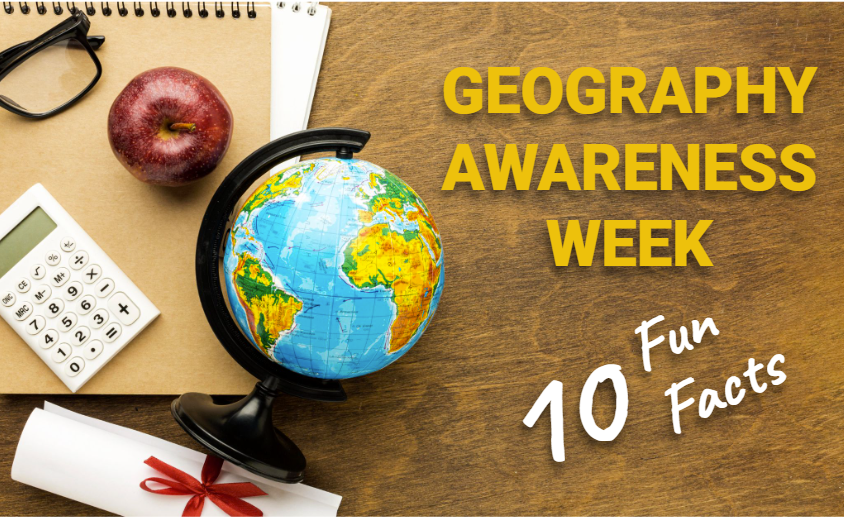
November 11-15 2024 is Geography Awareness Week.
Geography is an integral part of any Social Studies class. Making connections between a region’s geographic features and its history and culture can broaden students’ understanding of history. Some facts about geography will not only add flavor to a social studies unit but will also wow the students with unexpected answers and fun visuals.
Did you know…
#1. The smallest country in the world is Vatican City at only 0.2 square miles. The headquarters of the Catholic Church is located entirely in the city of Rome. Vatican City isn’t just the smallest country in land area, it is also the smallest country by population. Only about 600 people live there permanently, almost all of whom are clergy or members of the Swiss Guard, responsible for protecting the Pope.
#2. Unsurprisingly, the largest country in the world is Russia. What you may not know is Russia, with an area of 6,592,735 square miles, is almost twice the size of the second largest country in the world Canada, which comes in at 3,855,081 square miles. Over 60% of the land in Russia is forest, while over 4000 miles of the nation is tundra.
#3. Brazil is 11% larger than the contiguous 48 states of the United States of America. As a matter of fact, Brazil is the fifth largest country in the world. It is so big, that all of non-Russian Europe could fit inside of its borders!
#4. Asia is the largest continent in land area in the world. It is larger than North and South America combined! More people live in Asia (over 4 billion) than the rest of the world’s continents combined (almost 3 billion).
#5. The most common city name in the United States is Franklin, with 31. There are 26 cities in the world with a single letter as its name, two of which are located in America: B, Ohio and Y, Alaska. The original name of Los Angeles was El Pueblo de Nuestra Señora la Reina de los Ángeles del Río de Porciúncula. Translated in English it means The Town of Our Lady the Queen of Angels of the Porciúncula River.
#6. Africa includes 54 countries and over 2000 languages spoken. There are over 500 languages in Nigeria alone! The most widely spoken language is Hausa, which is the first language of over 35 million Africans and another 15 million people in other parts of the world.
#7. Canada contains over 300,000 islands, some of which are available for purchase for less than $1 million. The largest of these islands include Vancouver Island and Newfoundland.
#8. About 90% of the world’s population lives in the Northern Hemisphere. The only Southern Hemisphere nations that contain more than 50 million people are Indonesia and Brazil, at 227 million and 192 million, respectively.
#9. The Amazon rainforest represents more than half of the world’s rainforests and produces more than 20% of the world’s oxygen supply, contains 20% of all of the world’s plants and birds, and 10% of the world’s mammal species. 10% of the forest has been lost to agriculture in the last 50 years, with some forecasting the loss of the entire rainforest by 2030.
#10. The color red appears on the most national flags with 155. White is a close second with 144, and green is a distant third with 97. Purple appears in only six flags. Some national flags are almost identical due to a shared history. For example, blue, white, and red are common color combinations in Slavic nations, and many African nations use red, yellow, and green.
Use these facts as an introduction to a fun Geography Awareness Week lesson that can include a Fun Fact Scavenger Hunt. Ask your students to locate silly and surprising facts about each continent.
What other fun geography facts do you know? Leave them in the comments section! Be sure to visit HelpTeaching.com and try our free geography worksheets.
If you enjoyed this read, you might also like what KidsKonnect has to say. Check out their articles today.
100 Fitness Activities for the Whole Family
- 11 October //
- Posted in For Parents, Fun Facts //
- Tags : activities, family, fitness, physical education
- Comments Off on 100 Fitness Activities for the Whole Family

Physical fitness is essential to our health and has a big influence on our mental wellness too. Yet, with full work schedules, equally busy children, and lockdown restrictions, making the time for exercise too often falls to the bottom of the list. While May is officially National Physical Fitness and Sports Month, any time of the year is good for becoming more active. And being physically active is way more fun and much less of a chore when done together, we’ve put together a list of 100 fitness activities for the whole family. Whether you have toddlers, tweens, or teens, we’ve got you covered not just with fitness activities, but with improved family time too!
Host Backyard Games
Whether you’re in your yard or at a park, there’s nothing like open space to inspire movement. While they may not always show it, your children will get a kick out of seeing you acting like a kid again. Consider inviting friends and neighbors to join you in these outdoor games. You can even combine these activities into a full-fledged backyard Olympics!
1. Make and run an obstacle course
2. Take on the high seas with a game of pirate ship
3. Design, build, and play your own mini-golf course
4. Seek treasure or discover nature with a scavenger hunt
5. Play a game of soccer, volleyball, flag football or another team sport
6. Run relay races
7. Strategize as a team in a game of capture the flag
8. Get messy – play in the mud, have a frozen t-shirt race, engage in a shaving cream battle, or even slip on a water slide covered in chocolate syrup
Lend A Hand

Volunteering can keep you moving while you help out others and your community. Depending on the volunteer opportunity your family may be packing, cleaning, stacking, running, or building! So lend a hand, teach your children the importance of social responsibility, and work in some physical fitness while your family spends meaningful time together. Sites like VolunteerMatch can help connect you with the right cause for your family.
9. Help out at a bottle and can drive
10. Clean up litter along roads or trails
11. Participate in a run or walk for charity
12. Join a community building project like Habitat for Humanity
13. Collect, organize, and distribute food through your local food bank
14. Volunteer at a meal center
15. Explore new places while giving back – plan a family volunteer vacation
16. Lend a helping hand around the yard or home of a grandparent or neighbor in need.
Roll with Rainy Days
Rainy weather can be challenging for families with rambunctious children. Kids need to move, but a string of poor weather can dampen their spirits. Don’t let the weather impede your fitness goals. Instead, roll with the rain and keep the family moving!
17. Play indoor hide-and-seek
18. Challenge the family to a game of fitness bingo
19. Build a blanket fort and play in it
20. Make cardboard box cars, then race them
21. Crank up the tunes and do a freeze dance (think musical chairs)
22. Have a pillow fight
23. Play follow-the-leader
24. Dress up and walk the runway in a family fashion show
25. Play charades or other movement games
26. Pretend to belt out tunes in a family a lip sync battle
27. Put on a family talent show
28. Read and act out a movement story or video together
29. Kick up your heels and play a dance video game
30. Get outside and go puddle jumping
Do Chores
They’re not glamorous, but chores must be done. On the plus side, chores help burn calories. Divide tasks and make a morning of getting some things done around the home and yard. Turn on some background music and agree as a family on something fun to do together once the chores are finished.
31. Mow the lawn
32. Rake leaves – jump in the pile before picking it up
33. Try on old clothes, pass down or donate ones that no longer fit
34. Paint a room
35. Chop and stack wood
36. Walk the dog
37. Wash and clean out the car
38. Clean the windows
39. Sort through books, donate ones no longer wanted or needed
40. Vacuum the rugs and mop the floors
41. Run errands – walk if you can or park the car at the further spot in the lot
42. Plant a family tree
Get Adventurous
Teens may be more reluctant to spend time as a family than younger children. Engage them with these high adventure activities and embrace your wild side along the way! Due to the need for specialized equipment and professional instruction, adventure activities can be more expensive than other fitness options. However, check coupon sites as they often feature significant discounts to places that offer these activities.
43. Ride into the sunset on horseback
44. Rage the rapids on a rafting tour
45. Scale a wall at a rock gym
46. Get tangled up in a ropes course
47. Go mountain biking
48. Vacation by going on a family camping trip
49. Try indoor skydiving
50. Participate in a mud run or obstacle race as a team
51. Take a SCUBA certification course
52. Play laser tag
53. Train together for a CrossFit competition
Explore Someplace New
Getting kids out of their everyday environment can open their eyes to the larger world and spark excitement and curiosity. Whether you fly across the county to visit a new city or explore a local museum, a day of walking and discovering a new place adds up to a lot of steps! Be sure to check with your public library first, it may offer free or discounted passes to museums.
54. View works of art, explore history, or learn science at a museum
55. Visit a national park – families of 4th graders get free annual passes here
56. Take a walking tour of a city
57. Ride your bikes the length of a rail trail
58. Climb a mountain
59. Brave a cave tour
60. Put on costumes and join a historical reenactment
61. Go letterboxing or geocaching
62. Play on a playground your kids haven’t been to before
Make A Splash
There is nothing like playing in water during the heat of summer. Kids can spend all day splashing in a pool or digging in the sand, so join them! Many communities have public beaches or pools that are free or at a reduced cost for residents.
63. Run through the sprinkler
64. Ride the waves on a boogie or surfboard
65. Try paddleboarding
66. Have a squirt gun battle
67. Team up for a water balloon fight
68. Paddle a river or lake in canoes, kayaks, or paddle boats
69. Jump over waves
70. Hit a home run with water balloon baseball
71. Register emerging swimmers for lessons
Take On Winter Weather
Winter brings a unique set of challenges to staying fit. Don’t let the weather keep your family indoors. Rather, bundle up and take advantage of the fitness opportunities that come with snow and ice! By trying a new winter sport, your family may fall in love with an activity you can do together for years to come. If you don’t own winter sporting equipment borrow from friends or look for places that offer daily rentals.
72. Downhill ski or snowboard
73. Cross-country ski
74. Go ice-skating
75. Build a snow family
76. Have a snowball fight
77. Make snow angles
78. Shovel the driveway
79. Shovel a neighbor’s driveway
80. Explore the woods while snowshoeing
81. Go ice fishing
82. Hop on a sled
83. Try snow tubing
Create Healthy Eating Habits
Eating healthy is an essential part of any fitness plan. With hectic work, school, and extra-curricular schedules, setting aside time to prepare and share healthy meals can be challenging. But, we all must eat, so take the opportunity to teach your children lifelong eating habits while spending some quality time together!
84. Pack a healthy picnic and hike to a scenic spot
85. Take a cooking class as a family, check nearby grocery stores as some offer free programs
86. Set up a schedule where each family member is responsible for planning and cooking a meal
87. Involve children in packing their own lunches
88. Go to your local farmer’s market together
89. Go fruit picking at a nearby farm or orchard, then try a new recipe with the fruit
90. Cook one meal a week that features locally grown, seasonal food
91. Gather favorite family recipes and publish them in a cookbook – check out Blurb
92. Plant a home vegetable garden or potted herb garden
93. Join a community garden
94. Volunteer at your child’s school and help raise a school garden
95. Spice up dinnertime by planning a weekly themed meal night – from Meatless Mondays to Fancy Fridays, your kids will look forward to this new family tradition
Make Time for Mindfulness
The end of a harried day is the ideal time to come together as a family and create time for a few mindful moments. There are many wonderful free mindfulness videos and audio recordings available online or through your public library.
96. Practice yoga along with a video geared for kids or families
97. Dim the lights, get comfortable, and listen to a guided meditation recording
98. Try progressive muscle relaxation
99. Do some calming breathing exercises
100. Lay on a blanket in the yard or park and focus on the sounds around you or stargaze
How does your family stay fit and active? Share your ideas in the comments. Visit Help Teaching and browse our collection of free physical education printables!
If you enjoyed this read, you might also like what KidsKonnect has to say. Check out their articles today.
8 Reasons Why I Teach Banned Books… and You Should Too
- 15 September //
- Posted in For Parents, Teaching Resources //
- Tags : books, language arts
- Comments Off on 8 Reasons Why I Teach Banned Books… and You Should Too

It seems like every year a new book makes the news for being challenged or banned by a school. Books that have been banned run the gamut from Mark Twain’s Huckleberry Finn to The Holy Bible. While some parents and teachers have legitimate concerns, others have less valid reasons (a library patron in Toronto, Canada wanted to ban Hop on Pop because it encouraged children to use violence against their fathers). Regardless of whether books contain controversial content, they should still be accessible to students. Here are eight reasons why I teach banned books and why they should be accessible to students.
Why teach banned books: They Challenge Students to Consider Alternate Viewpoints
As a parent, your first instinct is often to shield your children from things you don’t want them to see, but you can’t hide the world from your children forever. Banned books are often challenged because they contain controversial content or don’t mesh with adults’ beliefs, but that doesn’t always mean they’re bad. Instead of simply banning a book that contains an alternate viewpoint, use the book as an opportunity to safely expose students to that viewpoint. While reading the book, use reading response activities to discuss what’s controversial about it and why people might disagree with the actions or viewpoints held in the book. If you’re a parent whose child has to read a book for school that you don’t agree with, read the book with your child and talk to him/her about the content. Explain to your child why you don’t agree with it and encourage your child to share his/her thoughts too.
They Introduce Students to Diverse Characters
Often children live in their own little world where their friends and family members largely think and act like they do. While there are some exceptions to this rule, most children don’t get the opportunity to experience people and places that aren’t familiar to them. Many books have been banned throughout history because they contain diverse characters that children may not have encountered before. For example, the book Nasreen’s Secret School: A True Story from Afghanistan was challenged because the main character says a prayer to Allah in the book and the picture book And Tango Makes Three was challenged because the main characters are two male penguins who raise a chick together.
It’s important to remember that reading a book with diverse characters doesn’t mean you support those characters’ lifestyles or thoughts. Reading books with diverse characters can help students understand the different types of people that exist in the world and help them better prepare to interact with those people when they encounter them.
They Take Students Out of their Comfort Zone
Why are most books banned? Some of the most common reasons are because they include:
- racial themes
- alternative lifestyles
- inappropriate language
- unpopular religious views
- sexual or violent content
- unpopular political views
- references to witchcraft or the occult
- characters doing drugs or smoking
All of these reasons for banning books have one thing in common: they make people uncomfortable. It’s not fun to feel uncomfortable. It’s not fun to read something that takes you out of your comfort zone or challenges you to look at a situation differently, but it happens a lot in life and it’s bound to happen to children at one point or another. Should third graders be required to read books that contain excessive violence or sexual references? No. Should an eleventh or twelfth grader? Maybe. Because the eleventh or twelfth grader is about to enter a world where these issues will appear and what better place to practice being taken out of your comfort zone than in the safety of the classroom or your own home?
They Teach Valuable Lessons
In addition to taking children out of their comfort zones, banned books can often teach valuable lessons about identity, tolerance, or even freedom. For example, the book The Art of Racing in the Rain teaches readers a valuable lesson about the grieving process. The book The Working Poor: Invisible in America teaches a lesson about the real problems the working poor in America face. Brave New World teaches students about the extremes of passion and offers a bleak view of the future that students can connect to the future of the world. The Adventures of Huckleberry Finn has been banned numerous times its use of the n word, despite being regarded as one of the most valuable pieces of American literature.
They Can Be Interpreted in Multiple Ways
A book that is banned in one school or district may be perfectly acceptable in another. Take the case of Hop on Pop. One person in Toronto thought it advocated violence against fathers, but how many others have read the book and seen something completely different. What about the book And Tango Makes Three? Are children likely to see it as more than a story about a family of penguins? You could write a book with nothing offensive in it and, as a adults, we are often more likely to find offensive content than children.
They May Be Banned for Silly Reasons
Sometimes this also leads to books being banned for silly reasons. Did you know Shel Silverstein’s A Light in the Attic was once banned in an elementary school because it encouraged children to break dishes instead of dry them? The popular Harriet the Spy was once banned because Harriet is a spy and being a spy means that she occasionally lies and gets into mischief. Are You There God? It’s Me, Margaret was banned because it talked about a girl getting her period. Brown Bear, Brown Bear, What Do You See? by Bill Martin was banned because an author with the same name wrote a book about Marxism. Before you turn down a book because it has been banned, consider the reason it was banned. You may realize you were avoiding a book for no good reason at all.
They Are Often Great Books
Frankly, no one takes the time to ban a bad book. Not usually anyway. Books become banned because they become popular and fall into the hands of a diverse group of people. At some point, they’re bound to offend one of those people. Some of history’s greatest authors – Toni Morrison, Mark Twain, F. Scott Fitzgerald, Judy Blume – have written books that have been banned. By refusing to teach or let children read banned books, you’re often causing them to miss out on great writing.
They Promote Free Speech
But at the end of the day, the main reason to teach banned books is because books should never be banned in the first place. If you live in the United States, you know that one of the greatest freedoms you have is the right to free speech. Banning a book suppresses the author’s right to free speech and also suppresses students’ right to access media. Yes, a book may be inappropriate for a particular age group or it may contain controversial content, but banning books is a form of a censorship, the same censorship people decry in third world countries, the same censorship that is warned against in books like Fahrenheit 451:
“Black people don’t like Little Black Sambo. Burn it. White people don’t feel good about Uncle Tom’s Cabin. Burn it. Someone’s written a book on tobacco and cancer of the lungs? The cigarette people are weeping? Burn the book. Serenity, Montag. Peace, Montag. Take your fight outside. Better yet, into the incinerator. Funerals are unhappy and pagan? Eliminate them, too. Five minutes after a person is dead he’s on his way to the Big Flute, the Incinerators serviced by helicopters all over the country. Ten minutes after a man’s speck of black dust. Let’s not quibble over individuals with memoriams. Forget them. Burn all, burn everything. Fire is bright and fire is clean.”
The solution to handling books that contain content someone doesn’t like isn’t to ban them. Instead, teachers and parents can use these books as a learning tool and discuss them with children in a safe environment. That doesn’t mean you have to read all controversial books, but it does mean you shouldn’t avoid everything just because someone says it’s no good.
If you enjoyed this read, you might also like what KidsKonnect has to say. Check out their articles today. For worksheets related to literature, check out our library or create your own tests!
Fun Family-Centered Activities for School Break
- 13 September //
- Posted in For Parents //
- Tags : activities for children, parenting
- Comments Off on Fun Family-Centered Activities for School Break

Between work and school, families don’t get to spend a lot of quality time together during the week. However, during school break, school is removed from the equation, opening up a bit more free time and giving families a chance to slow down and enjoy each other’s company. These family-centered activities will help you use school breaks as an opportunity to enjoy some positive interaction with your kids, bring some learning into your household, and accomplish something pretty incredible in the process.
No activity will fit every family perfectly, but these activities can be easily adapted to work for your family. They’re all designed to get you working together and interacting with your kids during the school break.
Here’s our list of fun activities for school break
1. Writing Stories
Use school break as the opportunity to write a story together as a family. It could be a story about the ultimate family vacation, an exaggerated event of something that happened to a member of your family, or a new fairy tale that you’ll pass along to generations. You can purchase a blank storybook from a teaching supply or craft store and fill it with your own words or pictures, or just type up the story on the computer and print it out for everyone to enjoy. Want to take it a step further? Turn your story into a short play or movie.
Not interested in writing an elaborate story? Sit around and play the “finish the story” game where you each take turns adding lines to an oral story. You can also check out Help Teaching’s Seasonal and Holiday worksheets which feature story starters and images designed to spark kids’ imaginations so they can write short creative stories, as well as other fun learning activities to keep kids’ brains sharp during school breaks.
2. Going on a Treasure Hunt
If there’s somewhere your kids have always wanted to visit, why not turn it into a treasure hunt or a map-reading adventure? You can use some of Help Teaching’s free geography printables to brush up on your map-reading skills. Then you can work with your kids to create a map and follow it to the treasure or the special place. While you may have to drive the car, your kids can still a good bit of the navigating.
If you don’t want to travel too far, look for geocaching or letterboxing activities in your area. With these activities kids must learn to read coordinates and uncover clues to help find unique messages, treasures, and other fun items left by other people.
3. Creating a New Invention
Let kids combine science, creativity, and problem-solving to come up with their own inventions during school break. With a kit like those from MaKey MaKey kids can make all kinds of computer-programmed inventions, such as a game controller made from Play-Doh or a piano made from bananas. The possibilities are endless and will get kids to not only have fun, but to make something really cool in the process.
While MaKey MaKey is really cool, you don’t have to spend money on an expensive kit either. Get kids to use items around the house to come up with simple inventions. For example, they may use a plastic soda bottle to make a holder for their MP3 player or a special wrist brace from a coat hanger and a sock. Did you know that the popsicle was invented by an 11-year-old and a 6-year-old invented a fanny pack for video games? Think of the cool things your kids could invent with your help. If you don’t have the materials on hand to make it, draw a photo and write a description of the invention so you can build it later.
4. Designing a Program
Similar to creating a new invention, help kids build their tech skills by learning to code and creating computer programs. As a family, you can use programs such as Scratch, Hopscotch, and Tynker to create games, stories, and fun animations. You may also have fun building and interacting in a virtual world with a program like Minecraft or just have fun building virtual cities and other LEGO creations as you play around with Build with Chrome. While computer-based activities may not seem like a family-centered activity, you can always pull up an extra chair to the computer desk and talk to each other as you design and build collaboratively.
5. Conducting Research
Maybe you’ve always wanted to explore your family’s history or there’s a topic you and your kids share an interest in. Use school break as a time to conduct a family-centered research project. Just like kids complete group projects at school, you can assign roles and have each family member contribute to the research. Then you can come together to share what you’ve learned. While you may not write a traditional research report, you could add details of the research to a family scrapbook or write a short book about your findings to add to your bookshelf.
6. Decorating Your Home
School breaks also give you a chance to enjoy some fun decorating projects around the home. While you may not want your kids’ help with decorating your living room, you could work on creating fun decorations for their own rooms or even let kids re-arrange or redecorate their entire room. Help Teaching’s art worksheets provide activities such as color wheels and quizzes on colors and tints to help get kids thinking about the color schemes they want in their rooms. You can work with them to draw up blueprints, head to the hardware store to find paint chips, and go to the fabric store to look for swatches, and then put it all together into a fun new room design. Even if funds don’t allow kids to really re-decorate their rooms, it can be fun for them to dream.
Which activity are you going to do with your kids during their next school break? Share your project ideas and results in the comments.
If you enjoyed this read, you might also like what KidsKonnect has to say. Check out their articles today.
Hispanic Heritage Month 2024 – Reading List for K-12
- 6 September //
- Posted in For Parents, Teaching Resources //
- Tags : literature, reading list
- Comments Off on Hispanic Heritage Month 2024 – Reading List for K-12

Hispanic Heritage Month (Sep. 15 – Oct. 15) is all about celebrating the contributions of Hispanic and Latino people to the United States. There’s no better way to celebrate Hispanic contributions and culture than through literature! Whether you’re looking for a book for a preschooler or a novel for a teenager, there are many amazing books written by Hispanic and Latino authors. Not sure where to start? We’ve highlighted a few of our favorites.
Pre-K through 2nd Grade
Abuela by Arthur Dorros
Imagine what life would be like if you could fly. In this fun picture book, Rosalba flies around Manhattan with her grandmother and learns a lot about life along the way. The story mixes English and Spanish words and helps kids learn about Hispanic culture.
Gracias Thanks by Pat Mora
What are you thankful for? No matter what language you speak, there are many things to be thankful for. Kids are challenged to find things they are thankful for, just like the young boy in this simple picture book by one of the best-known Hispanic authors for children.
Nino Wrestles the World by Yuyi Morales
Nino is a spectacular wrestler and can defeat all of the greats. Kids will love the exciting illustrations and sound words used throughout the books. Parents will love the Spanish words and pronunciation guides.
3rd through 5th Grade
Esperanza Rising by Pam Munoz Ryan
Pam Munoz Ryan is one of the best-known Hispanic authors for this age group and Esperanza Rising is one of the best-known Hispanic novels for kids. This story follows a young girl as she loses her father, moves to the United States, and loses her social status, all while discovering herself.
Return to Sender by Julia Alvarez
This book discusses cross-cultural friendships and keeping hold of your heritage while trying to assimilate. It follows the relationship between a young farm boy whose parents hire migrant workers to help keep their farm afloat. This novel has won many awards.
My Name is Maria Isabel by Alma Flor Ada
Every child goes through a phase where they must discover who they are and stand up for themselves. In this novel, Maria’s teacher wants to call her Mary, but Maria is a name that holds a lot of significance. It follows Maria and her family as they learn how to balance their heritage with their American life.
6th through 8th Grade
The Dreamer by Pam Munoz Ryan
Pablo Neruda is a famous Hispanic poet and The Dreamer offers a fictional take on his life. This award-winning novel tells the tale of a Chilean boy who goes on to become a famous poet despite having an incredibly negative father. It is a very motivational read for middle school.
Baseball in April and Other Stories by Gary Soto
Gary Soto has written numerous coming-of-age stories for children and young adults. This is one of his best-known collections and a great read for pre-teen and teenage boys. The collection, which has also won numerous awards, including the ALA Best Book for Young Adults, shares stories from Soto’s life growing up in California, and shows not only a Hispanic experience, but an experience all boys can relate to on some level.
I Lived on Butterfly Hill by Marjorie Agosin
This award-winning novel tells the story of Celeste, an eleven-year-old girl from Chile who is sent to live with her aunt in the United States. Not only does she have to learn how to navigate life in the United States, she must also come to terms with what is going on in her home country and worry about her parents who are still there.
9th through 12th Grade
House on Mango Street by Sandra Cisneros
This is one of the quintessential story collections that every student should read. The coming-of-age book follows Esperanza Cordero as she grows up and learns to connect her Latino culture with her desire for something better. It also includes the popular short story Eleven.
How the Garcia Girls Lost Their Accents by Julia Alvarez
This novel has won numerous awards and has been hailed as a “new classic” for the twenty-first century. It tells the tale of the four Garcia sisters who flee the Dominican Republic and must learn to start their lives again in America. Each one has a different experience, but all are connected.
Cuba 15 by Nancy Osa
Violet Paz does not know a lot about her Latina heritage and does not consider herself anything but American. In fact, she is half Polish. This book details how she comes to learn more about her Latina heritage as she plans her traditional coming-of-age party when she turns 15.
While these are some of our favorite books for Hispanic Heritage Month, we know there are many other great books out there. What are some of your favorite books that celebrate Hispanic and Latino culture?
Also, remember to check out our graphic organizers which you can use to help kids think critically and conduct an in-depth analysis of these classic texts.
For more worksheets for Hispanic Heritage month, visit our partner site KidsKonnect and browse their library for dozens of topics!
If you enjoyed this read, you might also like what KidsKonnect has to say. Check out their articles today.
Positive Use of Social Media – How to Encourage Your Students
- 6 September //
- Posted in For Parents, Teaching Resources //
- Tags : social media, teacher resources
- Comments Off on Positive Use of Social Media – How to Encourage Your Students

Social media is a regular part of students’ lives. They use it to communicate with friends, share photos and post status updates on a regular basis. In fact, 92 percent of teens, ages 13-17, report going online daily.
Unfortunately, this shift to more online communication has also brought more bullying into schools. Around 80 percent of young people believe that bullying is easier to do online and 43 percent of kids have experienced cyber-bullying, according to DoSomething.org.
However, teachers don’t need to make students to put away their phones. Instead, teachers can use these tools in the learning process. Not only will this help make learning more relevant, but it’s also an opportunity to encourage positive social media use – something students don’t learn about enough.
You don’t need to drop all the books and completely change course. Rather, bring social media into the classroom in small amounts, using projects or research as a chance to talk about positive and appropriate use of social media. Here are a few ways to make this work in your classroom.
Bring it Into Your Lessons
You don’t need to create social-media specific lessons to teach students how to use social media in a positive way. Simply bring these tools into your current lesson plans, giving them a chance to learn by doing.
Here are a few fun and simple ideas to do just that:
Use Twitter to Research: Show students that Twitter can be used for more than sharing their personal thoughts. Ask them to research and source at least three tweets for their next project. This will also give them a chance to practice deciphering between good and bad sources of information.
Use Blogs for Work: Teach students that they can put their thoughts onto “paper” and share the final product with the world by bringing blogging into your classroom. Not only will they get a thrill from sharing the work they put so much time into, but this also gives them experience with using various blogging tools and writing web content; skills that are quickly becoming required of 21st century students.
Use Social Platforms in a Different Way
Students use Pinterest to share funny memes and products that they want to buy. But this tool—and others—can be used in so many different ways in the classroom. Use the following ideas to show students how multi-dimensional these social platforms are.
Historical Figures’ Facebook Pages: Have students create a Facebook page for a historical figure of their choice. They’ll need to show you that they know everything about this character by creating status updates and filling out the varisous sections such as, “about me” and “interests.” (Idea from EdTechTimes.com)
Current Events Pinterest Boards: Each student creates their own board and adds a new current every week—or with whatever frequency you assign this task. Encourage students to go onto Pinterest and comment on their peers’ posts, allowing them to collaborate and socialize with an educational mindset.
Did you know students can utilize their social-emotional skills when navigating social media? See how SEL can benefit.
Create Class-Specific Social Groups
For most students, social media is used to chat with friends and share photos. With a classroom account, students can still do that, but within the framework of education and school. While you can use these groups to share homework, give test reminders, and further cultivate your classroom community, classroom social groups provide you with a great opportunity to encourage positive social media use.
For example:
Create group rules: Every student must abide by the rules, including using appropriate language, proper spelling—you not u; your not ur—which may translate to their social media use outside of school.
Create an anonymous concern form: Many students won’t report cyber-bullying for fear of someone finding out—90 percent of teens who have seen it say they ignored it. Provide students with a Google Form they can use to share any issues they’re having in the classroom group with regards to cyber-bullying or poor language use. While you should be constantly monitoring these platforms, students could write something and delete it before you see it.
Use Social-Focused Tools
If you or your students aren’t ready to fully use social media in the classroom, use tools that have similar collaboration and social features. This gives you a chance to lay down ground rules and set expectations for social media use without allowing students to log into Facebook in the middle of class. Try one of these simple tools.
Whooo’s Reading: Students call this tool “Facebook for reading,” because it incorporates many similar features of Facebook including commenting and “liking.” However, it also uses gamification features to motivate students to read more, while using fun CCSS-aligned comprehension questions to ensure they understand the text.
Google Docs: Allow students to use Google Docs for peer reviewing. With this tool, they can collaborate and comment in real-time, similar to Facebook. Use this as a chance to talk about what makes an appropriate and helpful comment, versus one that is mean or inappropriate.
Diigo: Students use this web platform to tag websites, create a personal library, share with classmates, and structure research. This puts an educational spin on sharing and online chatting, while allowing you to monitor and guide the process and conversation.
Bringing social media into your classroom isn’t just about engagement, or giving students what they want, it can be beneficial in teaching how to use these platforms correctly. With cyber-bullying and teen social media use at an all-time high, teachers have an opportunity to change the course.
Jessica Sanders is the Director of Social Outreach for Learn2Earn, a San Diego-based education organization that offers Read-A-Thon fundraisers and reading motivation tools for teachers and schools. She grew up reading books like The Giver and Holes, and is passionate about making reading as exciting for young kids today as it has always been for her. Follow Learn2Earn on Twitter and Facebook, and check out their new ebook, How to Bring Technology Into the Classroom, just $2.99 on Amazon.com.


